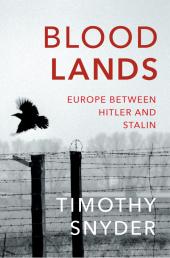 Neuerscheinungen 2011Stand: 2020-01-07 |
Schnellsuche
ISBN/Stichwort/Autor
|
Herderstraße 10
10625 Berlin
Tel.: 030 315 714 16
Fax 030 315 714 14
info@buchspektrum.de |

Timothy Snyder
Bloodlands, English edition
Europe Between Hitler and Stalin. Winner of the Hannah-Arendt-Preis für politisches Denken 2013
2011. 544 S. w. maps. 198 mm
Verlag/Jahr: RANDOM HOUSE UK; VINTAGE, LONDON 2011
ISBN: 0-09-955179-9 (0099551799)
Neue ISBN: 978-0-09-955179-9 (9780099551799)
Preis und Lieferzeit: Bitte klicken
Zwischen Stalins Russland und Hitlers Deutschland, in der Mitte Europas, starben in den Jahren von 1933 bis 1944 vierzehn Millionen Menschen, fast alle Zivilisten. Hier, in den heutigen Staaten Ukraine, Weißrussland, Polen und an der Ostseeküste, trafen die Kräfte der Roten Armee und der Wehrmacht aufeinander. In diesen Ländern lebten die meisten Juden, die Interessen Stalins und Hitlers überlappten, sowohl NKWD als auch SS schlugen zu.
A magisterial history of the lands that lie between Stalin´s Russia and Hitler´s Germany - where 14 million civilians were murdered during the years 1933-1944
Under Hitler and Stalin the Nazi and Soviet regimes murdered fourteen million people in the bloodlands between Berlin and Moscow.
The killing fields extended from central Polads to western Russia. For twelve savage years, on this bloodsoaked soil an average of one million individuals - mostly women, children and the aged - were murdered every year. Though in 1939 these lands became battlefields, not one of these fourteen million was killed in combat. They were victims of a murderous policy, not casualties of war.
Int his deeply unsettling and revelatory book, Timothy Snyder gives voice to the testimony of the victims through the letters home, the notes flung from trains, the diaries on corpses. It is a brilliantly researched, profoundly humane and authoritative bok that demands we pay attention to those that history is in danger of forgetting.
"A hugely important historian of this nightmarish era. Nobody has explained it this way before" William Leith Evening Standard


